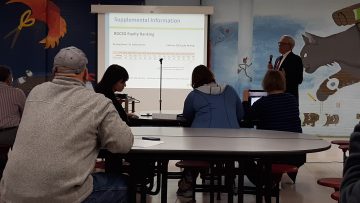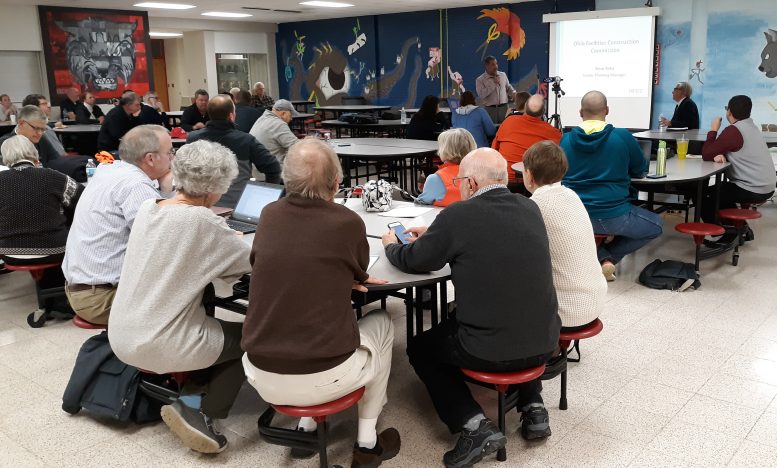By JAN LARSON McLAUGHLIN
BG Independent News
Bowling Green City Schools is low on the waiting list and low in the percentage it would get from the state for new or renovated buildings. But the interest is high among the task force members charged with finding a way to pay for school buildings. The theory is – some money at some point is better than no money at all.
Steve Roka, senior planning manager with the Ohio Facilities Construction Commission, met Wednesday evening with members of the finance and facilities task forces. The OFCC is responsible is dispersing state funding for a program that helps school districts pay for renovating or constructing new buildings.
School districts are ranked for funding based on a formula of their enrollment divided by the assessed property valuation.
That puts Bowling Green’s ranking at 506 – meaning funding would likely not be available for at least another 10 years. The formula puts the district in the 83 percentile – meaning the state would pick up 17 percent of the construction costs and the district would be responsible for 83 percent.
There are currently about 100 other school districts already waiting in line for the OFCC funds.

Steve Roka talks about OFCC funding.
“You’re at least 10 years away,” Roka said. “That can change. It could increase, it could decrease.”
Dave Conley, the consultant advising the school district’s finance task force, used the timeline of 10 to 15 years.
To some, that may seem like a long wait for the state picking up a small portion of the cost. But to others, that wait is not long considering it takes at least two years to complete building designs. And 17 percent can add up to a lot when it’s helping to fund a multi-million dollar project.
The average school district using the OFCC funding gets 20 to 40 percent of the construction costs from the state, according to Rick Savors, spokesperson for OFCC.
“Why not get something from the state,” Savors said on Thursday.
Task force member Ben Otley asked about the certainty of the funding in years to come.
“It’s a promise from the state – not a guarantee,” Roka said.
The Bowling Green district submitted an application for OFCC consideration in 2015, so the commission assessed the school buildings and offered some options. One of those options included:
- Renovating and adding onto Crim Elementary for $4.4 million.
- Renovating and adding onto Kenwood Elementary for $10.6 million.
- Demolition of Conneaut Elementary because of its poor condition, for $206,827.
- Renovating and adding on the high school for $31 million.
The total cost of that plan was approximately $46.8 million, with the state share being $8 million. Roka cautioned, however, that those figures were based on 2015 construction costs. Any renovation or new building costs would also be greater now since the OFCC started requiring storm shelter/safe rooms in 2017.
Roka also explained that the district’s ranking may fluctuate with the amount of money awarded from the state to the OFCC, and with the other requests made for the funds.
“Things can change year to year,” Roka said.
One certainty, he said, is that the demands are always greater than the available funding.
“There’s more need than we have funds to go around,” Roka said.
Since 1997, approximately $12 billion has been dispersed through the programs for K-12 schools. A total of 399 districts have been served, with 116 projects currently in the design or construction stages.
When the OFCC did the assessments on the BG schools in 2015, it set the following costs to renovate or replace with new buildings. OFCC recommends new buildings in cases where the renovation costs are greater than two-thirds of the replacement costs. Conneaut exceeds that ratio, and Kenwood is close to it.
- Bowling Green middle school and high school: $26 million to renovate; $74.6 million to build new. The renovation to replace ratio is 36 percent. (That, however, is an average for both buildings. Since the newer middle school and older high school are connected, they are considered one school.)
- Conneaut Elementary: $8.2 million to renovate; $10.6 million to build new. This school has the greater renovation to replace ratio of 78 percent.
- Crim Elementary: $2.4 million to renovate; $12.2 million for new. The ratio is 19 percent.
- Kenwood Elementary: $6.9 million to renovate; $11.3 million to build new. The renovation to replace ratio is 61 percent.
Those costs would have all increased since 2015, Roka said.
Task force member Chris Sabo asked if the district could appeal the ranking assigned to it by the state. Bowling Green’s district is at a disadvantage because of the high valuation of farmland and high salaries. Others mentioned the effect of the BGSU student population on the ranking.
Roka said some districts have challenged the rankings, but not successfully.
“We are required to follow that formula,” which puts poor districts ahead of wealthy ones, he said.
Task force member Ellen Dalton asked if inflexible standards have led some districts to not accept OFCC funds.
That has been true in the past, Roka said.
“They would rather not deal with the state, and that’s fine,” he said. “I respect that decision as well.”
However, the OFCC has made efforts to become more flexible. While districts do have to meet basic design requirements, there is more leniency, Roka said. However, there are still some items that go beyond the basic standards that the district would have to pay for all on its own.
Savors said on Thursday that over 20 years, the program has become less rigid.
“It has led us to adjust our standards,” Savors said. “We want the districts to have as much choice as possible.”
If buildings are renovated, they must be brought up to code at the same time, Roka said. In the case of renovations, there will also be costs for “swing space” to house students during construction.
To lock in the percentage of funding from the state, the district must spend $1 million on its building project within 13 months. And in order to get the state funding, the district has to pass the necessary levies to fund the local share.
“There’s a lot of moving parts to this,” Roka said.
Roka also cautioned that some districts start out with plans to renovate buildings, but end up switching to new buildings when they encounter costly construction problems in the existing buildings.
The OFCC funding can be used for:
- Building construction costs.
- Loose furnishings and technology infrastructure.
- Design and construction management fees.
- Allowances to abate and demolish abandoned buildings.
There are several different funding programs through the OFCC. The district could start working on the Expedited Local Partnership Program funding route now, Roka said. The state funding still won’t be available now, but the district could put its building expenses toward its share of the state program, he said.
The district could also try for the Exceptional Needs Program. However, on Thursday, Roka and Savors said that ENP program typically covers only the very worst buildings in the state – such as those with dangerous electric systems. That funding will only go for new buildings, not renovations.
On Wednesday evening, Conley referred to the ENP as a “beauty contest,” with the ugliest building in the state winning.
“It’s not going to get you far enough,” Roka said.
The finance task force’s next meeting is Dec. 19, at 7 p.m.





